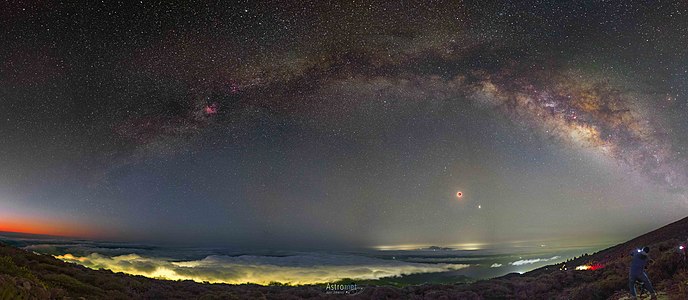Total lunar eclipse occurs in July 2018
Tuesday, July 31, 2018

Image: Ian Fieggen.
On Friday–Saturday —depending on observer's timezone— a total lunar eclipse occurred as the Moon was in the shadow of the Earth. As normal during such an eclipse, the Moon became faint and turned completely red as bluer light was scattered by the Earth's atmosphere. Totality of 1 hour and 43 minutes was the longest in the 21st century.
People were able to observe the eclipse from Australia, Africa, Asia, Europe, and South America. A volunteer named José Jiménez uploaded a photo of the incident today from Alt Empordà in Girona, Catalonia, Spain, featuring the Moon, Mars, and the milky way on the same photo.
German astronaut Alexander Gerst took photos of the Moon from the International Space Station and uploaded them to Flickr on the same day.
According to timeanddate.com, the timeline of the eclipse was as follows.
| Event | Time (UTC) July 27 |
|---|---|
| Start penumbral eclipse | 17:14:47 |
| Start partial eclipse | 18:24:27 |
| Start full eclipse | 19:30:15 |
| Maximum eclipse | 20:21:44 |
| End full eclipse | 21:13:11 |
| End partial eclipse | 22:19:00 |
| End penumbral eclipse | 23:28:38 |
Mars was also visible near the Moon; coming this week, reported 9News, closer to Earth than at any time since 2003.
Sources
- "Why Does the Moon Turn Red?" — TimeAndDate, August 1, 2018
- Dave Mosher. "An astronaut photographed the 'blood moon' from the International Space Station, and his pictures are haunting" — Business Insider, Australia, July 31, 2018
- "27–28 July 2018 — Total Lunar Eclipse" — TimeAndDate, July 28, 2018
- "Longest Blood Moon eclipse soars over Bagram" — United States Air Force, July 28, 2018
- "Stargazers treated to longest lunar eclipse of the century" — 9News, July 28, 2018











